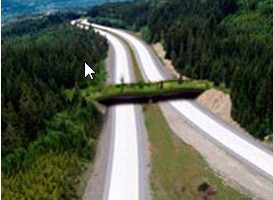Wildlife Corridor Conservation Act introduced in Congress
July 6, 2010
from Freedom Advocates
Politicians and other agents of UN Agenda 21 are inundating us with overlapping schemes that quietly and deliberately drown our property rights and freedom. For surefire evidence, take a look at the plot that is outlined in the U.S. Congress - H.R. 5101 Wildlife Corridors Conservation Act of 2010. This bill includes transboundary tax-payer funded projects for wild animal bridges and tunnels, increasing roadless areas and other means to capture more natural resources and private property for government and its partners.
Sample projects already in existence:
Wildlife Overcrossing at Easton Hill, WA |
www.chattoogariver.com |
|---|
H.R. 5101 states that "The Secretary, in cooperation with the States and Indian tribes, shall develop a Habitat and Corridors Information System, that shall include maps and descriptions of projected shifts in habitats and corridors of fish and wildlife species in response to climate change; and to assess the impacts of existing development on habitats and corridors."
The System is charged with identifying, prioritizing and describing "key parcels of non-Federal land (i.e. state lands and private property) located within the boundaries of units of the National Park System, National Wildlife Refuge System, National Forest System, or National Grassland System that are critical to maintenance of wildlife habitat and migration corridors." This is way over and above what the federal government has already swallowed up under other guises.
Congress and other elites are desperately clinging to the fraud of man-made global warming in an attempt to illegitimately wrest control of private property.
Many people still nominally own and pay taxes on their private property but if their property is even slightly proximate to the imagined wildlife corridors, then animals rule as "new habitat" is created for them in response to "climate change" and other "threats" (meaning people). It doesn't matter that grandma's house has been there for 100 years and she and the animals get along fine. Not anymore, with this bill government will determine what if any use might be made of land that falls in or near corridors invented ostensibly to protect animals (in truth this is done to take private property and to control the human population).
The difference between this bill and previous wildland's programs is that this one doesn't just have teeth, it has fangs. Not only does it have "strong language calling on agencies to actually take steps to protect corridors" but it also calls for a funding mechanism (more taxes) to support "such protective action."
In short, we will be footing the bill for the global elite to further control our property and diminish our freedom under the guise of habitat protection. And "the Secretary of the Interior may transfer funds to the Foundation under this subsection in advance, without regard to when expenses are incurred." How many of us can get paid whenever we want, even if we haven't yet done the work?
Here are a few examples of Wildlife Corridor Program across the United States. Once again they are bad programs hiding behind pretty pictures and phony words. Rim of the Valley Los Angeles Basin, California, Buffalo Commons Plains States, USA and Yellowstone to Yukon or "Y to Y" plus there are many more.
Norman MacLeod of Washington explains that HR 5101 incorporates the legislative provisions of Section 481 of HR 2454 (the House version of the climate bill) and Section 6009 of the Kerry-Lieberman climate bill draft. These sections authorize a wildlife corridors information system.
HR 5101 builds on this with implementation programs, mostly to be housed with the U.S. Fish and Wildlife Service. Funding mechanisms and public-private structures are included. The bill has been referred to the House Natural Resources Committee.
This bill is intended to lead to the formal creation of several continental-scale wildlife corridor systems that include core habitat, connectivity, and buffer systems that will impact livelihoods, homes, ranches, farms, access to resources, outdoor recreation and more.
The bill can be tracked at www.thomas.gov

